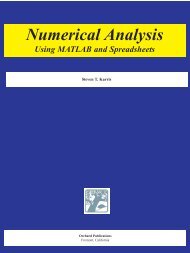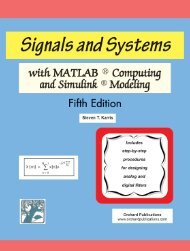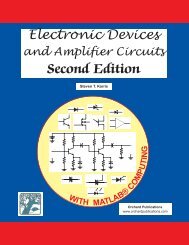endof-
Signals & Systems Front Cover FOURTH.qxp - Orchard Publications
Signals & Systems Front Cover FOURTH.qxp - Orchard Publications
Create successful ePaper yourself
Turn your PDF publications into a flip-book with our unique Google optimized e-Paper software.
Chapter 5State Variables and State EquationsThis chapter is an introduction to state variables and state equations as they apply in circuitanalysis. The state transition matrix is defined, and the state−space to transfer functionequivalence is presented. Several examples are presented to illustrate their application.5.1 Expressing Differential Equations in State Equation FormAs we know, when we apply Kirchoff’s Current Law (KCL) or Kirchoff’s Voltage Law (KVL) innetworks that contain energy−storing devices, we obtain integro−differential equations. Also,when a network contains just one such device (capacitor or inductor), it is said to be a first−ordercircuit. If it contains two such devices, it is said to be second−order circuit, and so on. Thus, a firstorder linear, time−invariant circuit can be described by a differential equation of the formdya 1----- + adt 0 yt () = xt ()(5.1)A second order circuit can be described by a second−order differential equation of the same formas (5.1) where the highest order is a second derivative.An nth−order differential equation can be resolved to n first−order simultaneous differentialequations with a set of auxiliary variables called state variables. The resulting first−order differentialequations are called state−space equations, or simply state equations. These equations can beobtained either from the nth−order differential equation, or directly from the network, providedthat the state variables are chosen appropriately. The state variable method offers the advantagethat it can also be used with non−linear and time−varying devices. However, our discussion willbe limited to linear, time−invariant circuits.State equations can also be solved with numerical methods such as Taylor series and Runge−Kutta methods, but these will not be discussed in this text * . The state variable method is bestillustrated with several examples presented in this chapter.Example 5.1A series RLCcircuit with excitationv S () t = e jωt(5.2)* These are discussed in “Numerical Analysis Using MATLAB and Excel”, Third Edition, ISBN 978-1-934404-03-4.Signals and Systems with MATLAB ® Computing and Simulink ® Modeling, Fourth EditionCopyright © Orchard Publications5−1







